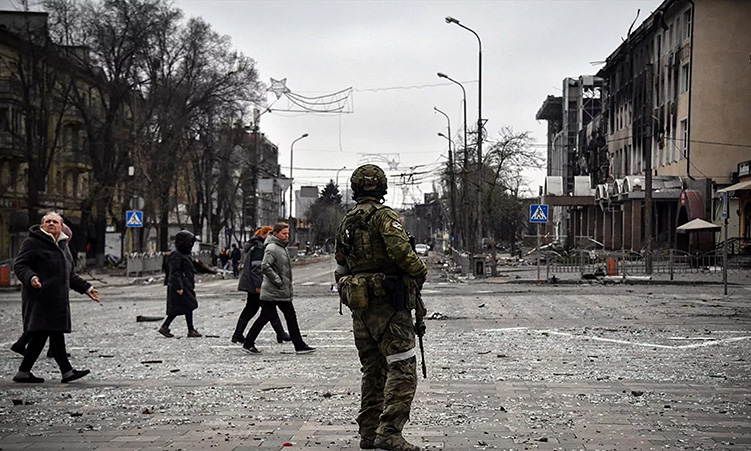LONDON – Oil’s record jump to US$139 a barrel at the end of last week defies any single explanation, although some leading analysts and producers predict the price could yet go higher.
Crude jumped US$10,75 on Friday to US$139,12, taking two-day gains to more than US$16. Some put the move down to comments by an Israeli minister about a possible attack on Iran, the world’s fourth-largest producer.Others cited strong oil market fundamentals.”There is a strong fundamental baseline to all of this,” said Kevin Norrish, oil analyst at Barclays Capital.”On top of that, Iran has come back onto people’s radar screens.”Iran’s dispute with the West over Tehran’s nuclear work had until last week faded in importance to oil investors, although the comments from Israel’s transport minister Shaul Mofaz sparked a scramble to buy.Banks such as Goldman Sachs and Barclays are prominent among those saying oil market fundamentals are a key factor in rising prices.Producers, including OPEC, tend to blame factors other than supply, such as speculation.Citigroup, in a note on Monday, said the broader themes behind oil’s latest jump were probably disappointing growth in supply and robust world demand, and prices could rally even further.World demand, while crimped by record prices, is still expected to rise by about one million barrels per day (bpd) this year, while supply from producers outside OPEC is at risk of posting no growth, the bank said.”Until clear evidence emerges that demand is moving towards negative territory in absolute terms, a break of the bull run in oil is unlikely,” the bank said.For some, oil’s jump last week defies explanation and is comparable to financial market bubbles of the past, such as the 1990s dot-com boom.”If anyone tries to spin a rational explanation as to what transpired last Thursday and Friday in the energy complex, then just tune them out or better yet, punch them in the nose,” analysts The Schork Report said.That aside, others in the market pointed to a renewed bout of dollar weakness for fuelling last week’s price jump.European Central Bank President Jean-Claude Trichet signalled a possible interest rate hike later this year, pushing the single European currency higher against the dollar and sparking oil’s latest surge.Still, those comments could prove bearish for oil should they lead to rate increases by the US Federal Reserve and other central banks, argued John Kemp, economist at RBS Sempra.”It is far from clear that the confluence of events last week was really bullish for the oil market at all,” he said.The weakness of the US currency has been a major factor behind this year’s commodity price gains as dollar-denominated raw materials offer a potential hedge against inflation.Other explanations for the rally emphasised fundamentals.According to the International Energy Agency, the lack of a rise in oil inventories in the second quarter – a time when they usually rise – and concern about Iran were reasons behind Friday’s price jump.”I think as a result of that we saw a surge of a combination of risk management buying and a reluctance to sell,” said Lawrence Eagles, head of the Oil Industry and Markets Division at the Paris-based IEA.But many oil producers, including the Organisation of the Petroleum Exporting Countries and some of the world’s largest fully publicly traded oil firms, say supply is enough and blame speculation for rising prices.OPEC officials have lined up to say the exporter group does not need to pump more and Jeroen van der Veer, head of Royal Dutch Shell Plc, has blamed market “psychology”, not shortages, for record prices.While they cite different reasons for oil’s rally than investment banks such as Citigroup and Goldman, some OPEC officials also predict that oil will rally even higher.”I forecast that by the end of summer the price of oil will reach US$150,” a senior Iranian oil official, Mohammad Ali Khatibi, was quoted on Sunday as saying.- Nampa-Reuters (Additional reporting by Muriel Boselli, editing by Peg Mackey) Factbox: Whys and wherefores Some of the major factors that have driven the oil market higher: DOLLAR WEAKNESS AND FUNDS A combination of weaker performance in other asset classes and expectations of continued strength across the commodities complex has drawn in investors and speculative funds, providing further support for the market.An added incentive for them has been the weakness of the dollar against other major currencies, which makes dollar-denominated commodities relatively cheap.They are also seeking an inflation hedge, as commodities tend to rise when other asset classes fall.OPEC The Organisation of the Petroleum Exporting Countries (OPEC) has been at the forefront of those citing speculation and a weak dollar as the reason for higher prices, saying it is pumping enough oil to keep the market balanced.Saudi Arabia, the biggest OPEC producer, is expected to raise output close to 9,5 million barrels per day (bpd) in June up from around 9,1 million bpd in May.OPEC has not officially increased output since a meeting last September and has no plans to meet formally until September 9.PEAK OIL? Some analysts have questioned whether OPEC is capable of raising its output significantly.The so-called pessimists have argued the world’s oil supplies are at or near a peak.Optimists say there is still plenty more oil and improved technology will ensure it can be extracted from the ground, but a host of political issues has hindered production from many of the biggest reserve holders.Iraq’s output has been disrupted by years of sanctions and then war.Sanctions have also limited exploration in Iran and violence has interrupted flows in Nigeria.Adding to the difficulties of getting oil out of the ground, high prices have fuelled a trend for resource nationalism, or resource-holders seeking to keep the bulk of their natural wealth for themselves.The biggest OPEC producers already prohibit foreign operators from accessing their oil reserves.Non-OPEC Russia, the world’s second biggest oil exporter, has also been limiting foreign involvement in its upstream while its output has stagnated.DEMAND There is mounting evidence high prices have begun to erode demand, but continued growth in China and other emerging economies is expected to offset the impact of any fall in developed countries.While high taxes reduce demand in some developed economies, subsidies spur consumption in emerging economies.In the developed world, some governments are considering reducing taxes, while emerging economies, struggling with the growing burden of subsidies, have started to lift them.REFINERY BOTTLENECKS Even if there is plenty of crude to meet demand that does not mean there is an adequate supply of refined products, such as diesel and petrol, as there is a lack of refining capacity.Faced with planning battles and reluctance to invest in the downstream sector, which is not always profitable, the world’s biggest energy consumer the United States has not built a new refinery for decades.Nampa-ReutersSome put the move down to comments by an Israeli minister about a possible attack on Iran, the world’s fourth-largest producer.Others cited strong oil market fundamentals.”There is a strong fundamental baseline to all of this,” said Kevin Norrish, oil analyst at Barclays Capital.”On top of that, Iran has come back onto people’s radar screens.”Iran’s dispute with the West over Tehran’s nuclear work had until last week faded in importance to oil investors, although the comments from Israel’s transport minister Shaul Mofaz sparked a scramble to buy.Banks such as Goldman Sachs and Barclays are prominent among those saying oil market fundamentals are a key factor in rising prices.Producers, including OPEC, tend to blame factors other than supply, such as speculation.Citigroup, in a note on Monday, said the broader themes behind oil’s latest jump were probably disappointing growth in supply and robust world demand, and prices could rally even further.World demand, while crimped by record prices, is still expected to rise by about one million barrels per day (bpd) this year, while supply from producers outside OPEC is at risk of posting no growth, the bank said.”Until clear evidence emerges that demand is moving towards negative territory in absolute terms, a break of the bull run in oil is unlikely,” the bank said.For some, oil’s jump last week defies explanation and is comparable to financial market bubbles of the past, such as the 1990s dot-com boom.”If anyone tries to spin a rational explanation as to what transpired last Thursday and Friday in the energy complex, then just tune them out or better yet, punch them in the nose,” analysts The Schork Report said.That aside, others in the market pointed to a renewed bout of dollar weakness for fuelling last week’s price jump.European Central Bank President Jean-Claude Trichet signalled a possible interest rate hike later this year, pushing the single European currency higher against the dollar and sparking oil’s latest surge.Still, those comments could prove bearish for oil should they lead to rate increases by the US Federal Reserve and other central banks, argued John Kemp, economist at RBS Sempra.”It is far from clear that the confluence of events last week was really bullish for the oil market at all,” he said.The weakness of the US currency has been a major factor behind this year’s commodity price gains as dollar-denominated raw materials offer a potential hedge against inflation.Other explanations for the rally emphasised fundamentals.According to the International Energy Agency, the lack of a rise in oil inventories in the second quarter – a time when they usually rise – and concern about Iran were reasons behind Friday’s price jump.”I think as a result of that we saw a surge of a combination of risk management buying and a reluctance to sell,” said Lawrence Eagles, head of the Oil Industry and Markets Division at the Paris-based IEA.But many oil producers, including the Organisation of the Petroleum Exporting Countries and some of the world’s largest fully publicly traded oil firms, say supply is enough and blame speculation for rising prices.OPEC officials have lined up to say the exporter group does not need to pump more and Jeroen van der Veer, head of Royal Dutch Shell Plc, has blamed market “psychology”, not shortages, for record prices.While they cite different reasons for oil’s rally than investment banks such as Citigroup and Goldman, some OPEC officials also predict that oil will rally even higher.”I forecast that by the end of summer the price of oil will reach US$150,” a senior Iranian oil official, Mohammad Ali Khatibi, was quoted on Sunday as saying.- Nampa-Reuters (Additional reporting by Muriel Boselli, editing by Peg Mackey) Factbox: Whys and wherefores Some of the major factors that have driven the oil market higher: DOLLAR WEAKNESS AND FUNDS A combination of weaker performance in other asset classes and expectations of continued strength across the commodities complex has drawn in investors and speculative funds, providing further support for the market.An added incentive for them has been the weakness of the dollar against other major currencies, which makes dollar-denominated commodities relatively cheap.They are also seeking an inflation hedge, as commodities tend to rise when other asset classes fall.OPEC The Organisation of the Petroleum Exporting Countries (OPEC) has been at the forefront of those citing speculation and a weak dollar as the reason for higher prices, saying it is pumping enough oil to keep the market balanced.Saudi Arabia, the biggest OPEC producer, is expected to raise output close to 9,5 million barrels per day (bpd) in June up from around 9,1 million bpd in May.OPEC has not officially increased output since a meeting last September and has no plans to meet formally until September 9.PEAK OIL? Some analysts have questioned whether OPEC is capable of raising its output significantly.The so-called pessimists have argued the world’s oil supplies are at or near a peak.Optimists say there is still plenty more oil and improved technology will ensure it can be extracted from the ground, but a host of political issues has hindered production from many of the biggest reserve holders.Iraq’s output has been disrupted by years of sanctions and then war.Sanctions have also limited exploration in Iran and violence has interrupted flows in Nigeria.Adding to the difficulties of getting oil out of the ground, high prices have fuelled a trend for resource nationalism, or resource-holders seeking to keep the bulk of their natural wealth for themselves.The biggest OPEC producers already prohibit foreign operators from accessing their oil reserves.Non-OPEC Russia, the world’s second biggest oil exporter, has also been limiting foreign involvement in its upstream while its output has stagnated.DEMAND There is mounting evidence high prices have begun to erode demand, but continued growth in China and other emerging economies is expected to offset the impact of any fall in developed countries.While high taxes reduce demand in some developed economies, subsidies spur consumption in emerging economies.In the developed world, some governments are considering reducing taxes, while emerging economies, struggling with the growing burden of subsidies, have started to lift them.REFINERY BOTTLENECKS Even if there is plenty of crude to meet demand that does not mean there is an adequate supply of refined products, such as diesel and petrol, as there is a lack of refining capacity.Faced with planning battles and reluctance to invest in the downstream sector, which is not always profitable, the world’s biggest energy consumer the United States has not built a new refinery for decades.Nampa-Reuters
Stay informed with The Namibian – your source for credible journalism. Get in-depth reporting and opinions for
only N$85 a month. Invest in journalism, invest in democracy –
Subscribe Now!










